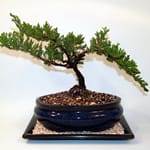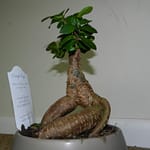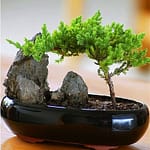What Bonsai Is Not
Bonsai is not what is sold in big box stores. These are what the bonsai community refers to as “mall bonsai” or “mallsai.” Some examples of mallsai are as follows.
Bonsai is not meant as an indoor hobby. There are a few plants that can survive (not thrive) inside, namely Jade, Ficus, and Chinese Elm, but plants are meant to be outside. If something is sold as an indoor bonsai and it is not one of these 3 species it is being labeled incorrectly usually in an attempt to sell more bonsai. Even though these 3 species can survive inside, they all prefer to be outside during the growing seasons so they can thrive. I personally never suggest a bonsai come inside. I put my Chinese Elms outside year-round, and only bring my Ficus inside when temperature drop too low for it to survive.
Bonsai is not always a great gift. I compare it to buying an artist a piece of artwork. Unless you know them as an artist, it is highly unlikely that you can guess what type, style, colors, artist, or meaning they prefer in their art. It can be difficult to understand how to properly care for a bonsai, or to be sure that someone has the time or ability to keep up with the care of their tree. If someone already has bonsai as a hobby you might take caution in buying a gift, as they might have a preference on types, styles, or species of bonsai they prefer. The best route would be to ask them if they need any soil, wire, tools, pots, or if they’re comfortable with you picking a bonsai out for them.
Bonsai are not cheap. The investment in time, work, and materials in a bonsai that seems small and inexpensive can be profound. People will scoff when you have a 20 year old Juniper that you’ve trained and want to sell for $200, but that is cheap considering everything you’ve done to it. Bonsai will teach you patience as you’ll be chomping at the bit to get to work. Many that begin the journey of bonsai quickly realize their need for more trees and more money. Welcome to Bonsai.
Pre-Bonsai vs Bonsai
Pre-bonsai includes nursery stock and is not in a bonsai pot. A plant takes several years of development before it can be refined and considered a bonsai. A couple of examples are the following:
Plants have to be grown in bigger containers or in the ground for development of the trunk and branches. Growth in a bonsai pot is considerably slower because the amount of space in a bonsai pot is much smaller. Consider this photo of two maples, both 3 years old and grown in the pots shown:

Pre-bonsai should be moved to bonsai pots once the trunk size, branches, and height have been acquired.
How Does It Look Like A Large Tree?!
Making a small tree look like a large tree is the essence of bonsai artistry. There are several things that are sought after to make a tree look so large when being so small. These things are: thick trunks with taper, branches that progressively get small as you go up, nebari or surface roots, and what we call ramification.

This Chinese Elm in the Winter season will be great to demonstrate ramification and taper. You can see the size of the trunk slowly gets smaller as you go up towards the apex. This have great taper to the trunk as well as the side branches. You’ll see the branches at the bottom have a thick branch connecting to the trunk. This provide scale to the tree and makes it look realistic. Ramification is seen through the branches as they deviate from the trunk. The branches are fine, not ‘twiggy’, and split often which is how we get dense growth of leaves.

While the Chinese Elm above didn’t have great nebari, this tree has fantastic surface roots that give age to the tree. This nebari has to be developed from early on and can require specific techniques to do so if not properly grown.
Pruning and Wiring
Pruning and wiring are the techniques that one can seemingly never master. They are absolutely critical to creating magnificent bonsai. All trees will either be significantly pruned or wired in their lifetime. Wiring is required to keep trees within the preferred shape while providing density of growth. Pruning helps to develop branches lower (back-budding), create smaller inter-nodes (growth density), and control direction of the trees growth.


You can see from both of these images the effect wiring can have on the overall look of a tree. Both pruning and wiring are indispensable skills that need continual improvement. Without these techniques bonsai would be much less appealing to the eyes.
Watering and Soil

Perhaps the most important parts of bonsai are the soil they grow in and how you water them. These are the basic things that keep your trees alive. Typical potting soil is not what bonsai trees are planted in. They are planted in mostly inorganic soil components such as volcanic rock, pumice, akadama, turface, etc. You can buy many different soil blends online, and the best soil mixture depends on your geographical location. Soil is also highly debated and I’ll happily explain that in another post sometime. Watering is not something that can be put on drip irrigation. Bonsai are watered when needed, not daily, or hourly. This may change depending on the plant, season, soil mixture, and weather. This is typically the way most beginners kill their trees.
If you’re looking for more information on how to care for your bonsai tree you can read about it here: https://happydiyhome.com/bonsai/
To learn about specific care and information head to my Bonsai Information page



